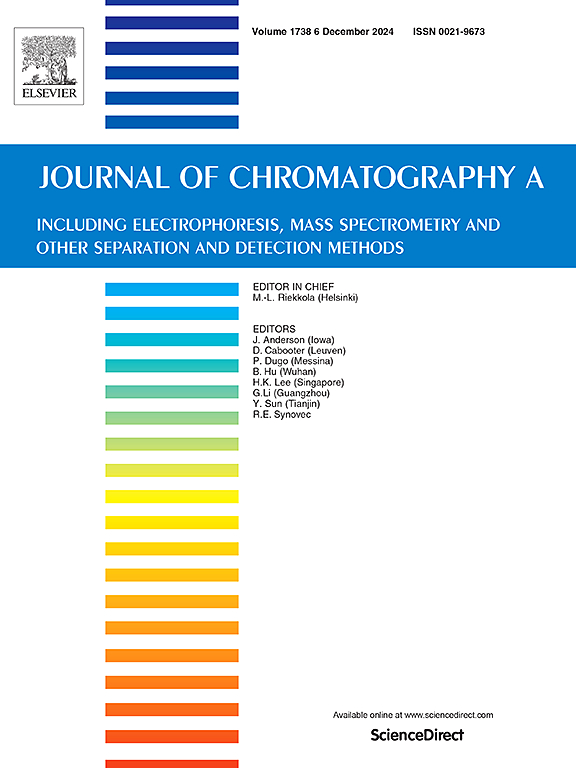基于数据后处理的超高效液相色谱-Q-Exactive Orbitrap质谱法鉴定和筛选清开灵口服液潜在的抗肺炎活性成分和靶标
IF 3.8
2区 化学
Q1 BIOCHEMICAL RESEARCH METHODS
引用次数: 0
摘要
清开灵口服液在临床上常用于治疗发烧和上呼吸道感染。此外,研究表明清开灵口服液具有抗肺炎的作用。然而,由于其复杂的药效物质基础,其药理研究和临床应用受到限制。针对这一问题,研究人员采用超高效液相色谱四极杆-Exactive Orbitrap质谱(UHPLC-Q-Exactive Orbitrap MS)和网络药理学方法对清开灵口服液中的化学成分进行了鉴定,并预测了其潜在的抗肺炎靶点和信号通路。共鉴定并初步定性了 150 种化合物,包括 35 种氨基酸及其衍生物、36 种有机酸、20 种萜类化合物、20 种生物碱、12 种苷类化合物、7 种黄酮类化合物和 20 种其他化合物。其中,有 14 种化合物的保留时间和质谱数据与参考物质的保留时间和质谱数据进行了比较,从而得到了准确的鉴定。此外,我们还通过密度函数理论进行了分子模拟计算,以确定化合物裂解反应的合理性,并进一步确认化合物的结构。此外,我们还通过网络药理学筛选出了 90 个关键靶点,特别是 PI3K-AKT、MAPK 和 TNF 信号通路。该方法首次全面鉴定了清开灵口服液的化学成分,阐明了其潜在的抗肺炎机理。该结果为药效物质研究和质量控制提供了有价值的参考和数据支持。本文章由计算机程序翻译,如有差异,请以英文原文为准。
Identification and screening of potential anti-pneumonia active ingredients and targets of Qing-Kai-Ling oral liquid via UHPLC-Q-Exactive Orbitrap mass spectrometry based on data post-processing
Qing-Kai-Ling oral liquid is commonly used clinically for the treatment of fever and upper respiratory tract infection. Moreover, studies have shown that Qing-Kai-Ling oral liquid has an anti-pneumonia effect. However, owing to its complex pharmacodynamic material basis, its pharmacological research and clinical application are limited. To address this problem, the chemical constituents of Qing-Kai-Ling oral liquid were identified by ultra-high performance liquid chromatography quadrupole-Exactive Orbitrap mass (UHPLC-Q-Exactive Orbitrap MS) and network pharmacology methods, which were used to predict its potential anti-pneumonia target and signalling pathway. A total of 150 compounds were identified and tentatively characterized, including 35 amino acids and their derivatives, 36 organic acids, 20 terpenoids, 20 alkaloids, 12 glycosides, 7 flavonoids, and 20 others. Among them, 14 compounds were accurately identified by comparing their retention time and mass spectrum data with those of reference substances. Additionally, we performed molecular simulation calculations via Density Function Theory to determine the plausibility of the compound cleavage reactions and further confirm compound structures. Furthermore, 90 key targets were screened through network pharmacology, with the particular focus on the PI3K-AKT, MAPK and TNF signalling pathways. This method achieved the first comprehensive identification of the chemical composition of Qing-Kai-Ling oral liquid and elucidated its potential mechanism of anti-pneumonia. The results provide valuable reference and data support for pharmacodynamic substance research and quality control.
求助全文
通过发布文献求助,成功后即可免费获取论文全文。
去求助
来源期刊

Journal of Chromatography A
化学-分析化学
CiteScore
7.90
自引率
14.60%
发文量
742
审稿时长
45 days
期刊介绍:
The Journal of Chromatography A provides a forum for the publication of original research and critical reviews on all aspects of fundamental and applied separation science. The scope of the journal includes chromatography and related techniques, electromigration techniques (e.g. electrophoresis, electrochromatography), hyphenated and other multi-dimensional techniques, sample preparation, and detection methods such as mass spectrometry. Contributions consist mainly of research papers dealing with the theory of separation methods, instrumental developments and analytical and preparative applications of general interest.
 求助内容:
求助内容: 应助结果提醒方式:
应助结果提醒方式:


